Australia: Climate Targets Further Threatened by Northern Territory Gas Plans

Will Steffen, Australian National University
Opposition leader Anthony Albanese’s announcement on Friday that a Labor government would adopt a target of net-zero emissions by 2050 was a big step in the right direction. But a bit of simple maths reveals the policy is too little, too late.
Perhaps the most robust way to assess whether a proposed climate action is strong enough to meet a temperature target is to apply the “carbon budget” approach. A carbon budget is the cumulative amount of carbon dioxide the world can emit to stay within a desired temperature target.
Once the budget is spent (in other words, the carbon dioxide is emitted), the world must have achieved net-zero emissions if the temperature target is to be met.
So let’s take a look at how Labor’s target stacks up against the remaining carbon budget.
The term “net-zero emissions” means any human emissions of carbon dioxide are cancelled out by the uptake of carbon by the Earth – such as by vegetation or soil – or that the emissions are prevented from entering the atmosphere, by using technology such as carbon capture and storage.
(The net-zero emissions concept is fraught with scientific complexities and the potential for perverse outcomes and unethical government policies – but that’s an article for another day.)
So let’s assume every country in the world adopted the net-zero-by-2050 target. This is a plausible assumption, as the UK, New Zealand, Canada, France, Germany and many others have already done so.
What then should the world’s remaining carbon budget be, starting from this year?
The globally agreed Paris target aims to stabilise the global average temperature rise at 1.5℃ above the pre-industrial level, or at least keep the rise to well below 2℃.
The Intergovernmental Panel on Climate Change (IPCC) estimates that from 2020, the remaining 1.5℃ carbon budget is about 130 GtC (billion tonnes of carbon dioxide). This is based on a 66% probability that limiting further emissions to this level will keep warming below the 1.5℃ threshold.
Current global emissions are about 11.5 GtC per year. So at this rate, the budget would be blown in just 11 years.
This is where the “net-zero emissions by 2050” target fails. Even if the world met this target, and reduced emissions evenly over 30 years, cumulative global emissions would be about 170 GtC by 2050. That is well over the 130 GtC budget needed to limit warming to 1.5℃.
So how far would Labor’s target go towards limiting warming to 2℃?
The carbon budget for that target is about 335 GtC. So a net-zero-by-2050 policy could, in principle, stabilise the climate at well below 2℃.
But a word of caution is needed here. The budgets I used above ignore two “jokers in the pack” that could slash the carbon budget and make the Paris targets much harder to achieve.
The first joker is that the carbon budgets I used assume we will reduce emissions of other greenhouse gases, such as methane and nitrous oxide, at about the same rate we reduce carbon dioxide.
But these potent non-CO₂ gases, which primarily come from the agriculture
sector, are generally more difficult to curb than carbon dioxide. Because of this, the IPCC recognises the carbon budget may have to be reduced if these gases are emitted at amounts higher than assumed.
Given the large uncertainties in how fast we can reduce emissions of these non-CO₂ gases, I’ve taken a mid-range estimate of their effect on the 1.5℃ carbon budget and consequently lowered it by 50 Gt. (This value is based on a median non-CO₂ warming contribution as estimated by the IPCC.) This reduces the remaining carbon budget to only about 80 Gt.
Second, the carbon budgets do not include feedbacks in the climate system, such as forest dieback in the Amazon or melting permafrost. These processes are both caused by climate change, at least in part, and amplify it by releasing more carbon dioxide into the atmosphere.
Emissions caused by feedbacks are expected to increase as global average temperature rises. Under a 1.5℃ rise, feedback processes could emit about 70 Gt of carbon dioxide. When the 1.5℃ budget is adjusted for both non-CO2 greenhouse gases and feedbacks, this leaves just one year’s worth of global emissions in the bank.
The corresponding reductions for the 2℃ warming limit reduce its carbon budget to 160 GtC. This is less than the cumulative emissions of 170 GtC if every country adopted a net-zero-by-2050 policy.
These calculations are confronting enough. But for Australia there is, in addition, a huge elephant in the room – or rather, in the coal mine.
Our exported emissions – those created when our coal, gas and other fossil fuels are burned overseas – are about 2.5 times more than our domestic emissions. Exported emissions are not counted on Australia’s ledger, but they all contribute to the escalating impacts of climate change – including the bushfires that devastated southeast Australia this summer.
So, what would an effective climate action plan look like? In my view, the central actions should be:
The striking students are right. We are in a climate emergency.
The net-zero-by-2050 policy is a step in the right direction but is not nearly enough. Our emission reduction actions must be ramped up even more – and fast – to give our children and grandchildren a fighting chance of a habitable planet.
Read more:
222 scientists say cascading crises are the biggest threat to the well-being of future generations
![]()
Will Steffen, Emeritus Professor, Australian National University
This article is republished from The Conversation under a Creative Commons license. Read the original article.
Patrick O’Connor, University of Adelaide; James B. Dorey, Flinders University, and Richard V Glatz, University of Adelaide
Among the vast number of native species damaged by the recent bushfire crisis, we must not forget native pollinators. These animals, mainly insects such as native bees, help sustain ecosystems by pollinating native plants.
Native pollinator populations have been decimated in burned areas. They will only recover if they can recolonise from unburned areas as vegetation regenerates.
Since the fires, Australia’s beekeeping industry has been pushing for access to national parks and other unburned public land. This would give introduced pollinators such as the European honeybee, (Apis mellifera) access to floral resources.
But our native pollinators badly need these resources – and the recovery of our landscapes depends on them. While we acknowledge the losses sustained by the honey industry, authorities should not jeopardise our native species to protect commercial interests.

The European honeybee is the main commercial bee species in Australia. It exists in two contexts: in hives managed for honey production, and as a pest exploiting almost every wild habitat. Honeybees in managed hives are classified as livestock, the same way pigs and goats are.
Feral and (to a lesser extent) managed honeybees contribute a broad variety of crop pollination services, including for almond, apple and lucerne (also called alfalfa) crops.
Read more:
Keeping honeybees doesn’t save bees – or the environment
Pollinators visit the flowers of the crop plants and ensure they are fertilised to produce fruit and seed. Beekeepers are often paid to put their bees in orchards since trees (such as almond trees) cannot produce a crop without insect pollination.
But native species of bees, beetles, flies and birds are just as important for crops. They are also essential for pollination, seed production and the regulation of Australia’s unique ecosystems – which evolved without honeybees.
The honeybee industry sustained considerable losses in the recent fires, particularly in New South Wales and on South Australia’s Kangaroo Island. Commercial hives were destroyed and floral resources were burned, reducing the availability of sites for commercial hives. This has prompted calls from beekeepers to place hives in national parks.
Currently, beekeepers’ access to conservation areas is limited. This is because bees from commercial hives, and feral bees from previous escapes, damage native ecosystems. They compete with native species for nectar and pollen, and pollinate certain plant species over others.
In NSW, honeybees are listed as a key threatening process to biodiversity.
Allowing commercial hives in our national parks compromises these valuable places for conservation and could do untold damage.
Australia’s native birds, mammals and other insects rely on the same nectar from flowers as honeybees, which are abundant and voracious competitors for this sugary food.
Also, honeybees pollinate invasive weeds, such as gorse, lantana and scotch broom. These are adapted to recover and spread after fire, and are very expensive to control.
Many native plant species are not pollinated, or are pollinated inefficiently, by honeybees. This means a concentration of honeybee hives in a conservation area could shift the entire makeup of native vegetation, damaging the ecosystem.
Bringing managed hives into national parks would also risk transferring damaging diseases such as Nosema ceranae to native bee species.
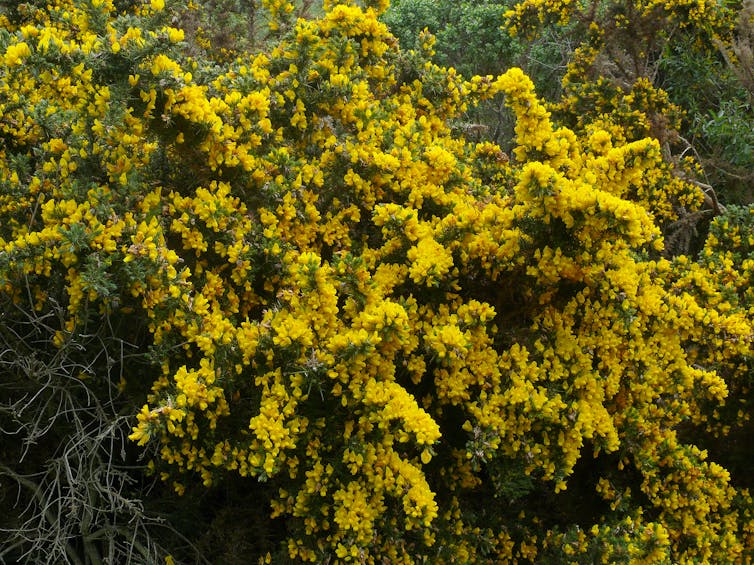
Currently, the commercially important honeybee is kept mainly on agricultural land. In national parks and reserves, native species are prioritised.
The amount of land set aside for conservation is already insufficient to preserve the species and systems we value.
Read more:
Fire almost wiped out rare species in the Australian Alps. Feral horses are finishing the job
Australia’s national parks also suffer from mismanagement of grazing by native and introduced animals, and other activities permitted in parks, such as road development and in some cases, mining.
National parks must be allowed to recover from bushfire damage. Where they are unburned, they must be protected so native plants and animals can recover and recolonise burned areas.
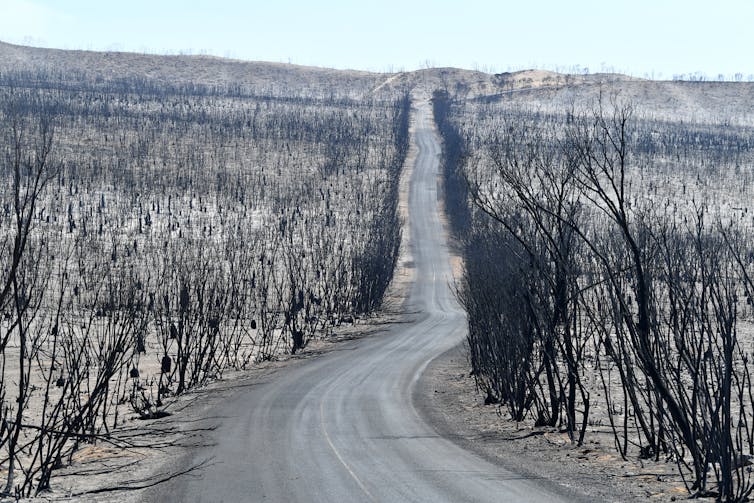
The demand for commercial beekeeping in national parks is a result of native vegetation being cleared for agriculture in many parts of Australia.
In the short term, one solution is for beekeepers to artificially feed their hives with sugar syrup, as is common practise in winter. Thus, they could continue to produce honey and provide commercial pollination services.
While production levels may fall as a result of the reduced feed, and honey may become more expensive, at least consumers would know the product was made without damaging native wildlife and vegetation.
A long-term solution is to increase the area of native vegetation for both biodiversity and commercial beekeeping, by stepping up Australia’s meagre re-vegetation programs.
Unfortunately, vegetation clearance rates in Australia remain extremely high.
Protecting and enhancing native vegetation would have both commercial and public benefits. Programs like the recently announced Agricultural Stewardship Package could be designed, to pay farmers for vegetation protection and revegetation.
Increasing vegetation in our landscapes is an insurance policy that will not only protect biodiversity, but support the honey industry.![]()
Patrick O’Connor, Associate Professor, University of Adelaide; James B. Dorey, PhD Candidate, Flinders University, and Richard V Glatz, Associate research scientist, University of Adelaide
This article is republished from The Conversation under a Creative Commons license. Read the original article.
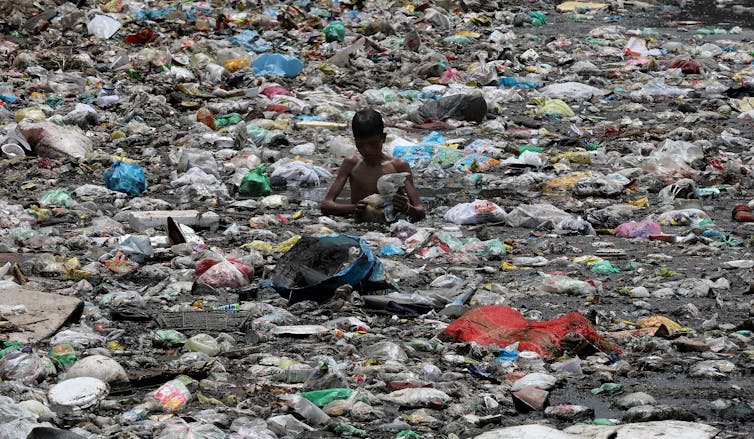
RAJAT GUPTA/EPA
Samuel Alexander, University of Melbourne
This article is the first in a three-part series on radical ideas to solve the environmental crisis.
As the Productivity Commission confirmed this week, Australia’s economy has enjoyed uninterrupted growth for 28 years straight. Specifically, our output of goods and services last financial year grew by 2%. Economists obviously see the growth of a national economy as good news – but what is it doing to the Earth?
Capitalism demands limitless economic growth, yet research shows that trajectory is incompatible with a finite planet.
If capitalism is still the dominant economic system in 2050, current trends suggest our planetary ecosystems will be, at best, on the brink of collapse. Bushfires will become more monstrous and wildlife will continue to be annihilated.
Read more:
222 scientists say cascading crises are the biggest threat to the well-being of future generations
As my research has sought to demonstrate, an adequate response to climate change, and the broader environmental crisis, will require creating a post-capitalist society which operates within Earth’s ecological limits.
This won’t will be easy – it will be the hardest thing our species has tried to do. I’m not saying capitalism hasn’t produced benefits for society (although those benefits are distributed very unequally within and between nations).
And of course, some people will think even talking about the prospect is naive, or ludicrous. But it’s time to have the conversation.
Economic growth generally refers to gross domestic product (GDP) – the monetary value of goods and services produced in an economy. Historically, and across the globe, GDP and environmental impact has been closely linked.
Capitalism needs growth. Businesses must pursue profits to stay viable and governments want growth because a larger tax base means more capacity for funding public services. And if any government tried to slow or stop growth for environmental reasons, powerful economic forces under capitalism would offer fierce resistance – with some businesses perhaps threatening to leave the nation altogether.
Most mainstream economists and politicians accept the science on the dire state of the planet, but not many people think capitalism is the problem. Instead, the dominant response to the ecological crisis is to call for ‘green growth’.
This theory involves producing ever more goods and services, but with fewer resources and impacts. So a business might design its products to have less environmental impact, or a product at the end of its life could be reused – sometimes called a ‘circular economy’.
If our entire economy produced and consumed goods and services like this, we mightn’t need to abandon the growth economics inherent to capitalism. Instead, we would just “decouple” economic growth from environmental impact.
There are several big problems with green growth theory. First, it isn’t happening at the global scale – and where it is happening to a limited extent within nations, the change is not fast or deep enough to head off dangerous climate change.
Second, the extent of “decoupling” required is simply too great. Ecological footprint accounting shows we need 1.75 planets to support existing economic activity into the future – yet every nation seeks more growth and ever-rising material living standards.
Read more:
No food, no fuel, no phones: bushfires showed we’re only ever one step from system collapse
Trying to reform capitalism – with a carbon tax here and some redistribution there – might go some way to reducing environmental harm and advancing social justice.
But the faith in the god of growth brings all this undone. The United Nations’ development agenda assumes “sustained economic growth” is the best way to alleviate global poverty – a noble and necessary goal. But our affluent living standards simply cannot be globalised while remaining within safe planetary limits. We need degrowth, which means planned contraction of energy and resource demands.
Let’s do the maths. If all humans lived like Australians, we’d need more than four planets to sustain us. Earth’s population is set to reach 9.7 billion by 2050. Our current levels of consumption do not add up.
Something resembling a fair share could involve developed nations reducing energy and resource demands by 50% or even 75% or more. This would mean transcending consumer lifestyles, embracing far more modest but sufficient material living standards, and creating new post-capitalist modes of production and distribution that aimed to meet the basic needs of all – not for limitless growth.
Read more:
To address the ecological crisis, Aboriginal peoples must be restored as custodians of Country
The “downshift” in material consumption can begin at the individual level where possible. But more broadly we must create local and sharing economies that don’t depend on globalised, fossil-fuelled distribution chains.
A range of social movements will be needed to persuade politicians to adopt systemic change.
Last year’s global student strikes and Extinction Rebellion protests were a good start. Over time, they could create widespread public momentum for an alternative, post-growth economy.
Ultimately, structural and policy inventions will be needed. This includes changes to land governance to make sustainable living easier. And we need to start having difficult but compassionate conversations about population growth.
I’m certainly not suggesting we adopt a centralised, Soviet-style state socialism. After all, a socialist economy seeking growth without limit is just as unsustainable as growth capitalism. We must expand our imaginations and explore alternatives.
I don’t have all the answers – and I think post-capitalist movements, now and in the future, will probably fail. But if we do not recognise capitalism’s inherent growth fetish as the central problem, we cannot formulate a coherent response.![]()
Samuel Alexander, Research fellow, Melbourne Sustainable Society Institute, University of Melbourne
This article is republished from The Conversation under a Creative Commons license. Read the original article.

AAP
Michelle Grattan, University of Canberra
Anthony Albanese will commit a Labor government to adopting a target of zero net emissions by 2050, in a speech titled “Leadership in a New Climate” to be delivered on Friday.
The opposition leader’s embrace of this target, which the ALP also took to the last election, is in line with the policies of state and territory governments, many companies and the Business Council of Australia. It is also the public stand of some Liberal moderates but is totally rejected by the Nationals and hard-line Liberals.
Prime Minister Scott Morrison has refused to adopt it.
“Currently no one can tell me that going down that path won’t cost jobs, won’t put up your electricity prices, and won’t impact negatively on jobs in the economies of rural and regional Australia, ” he said this week.
In his speech, released ahead of time, Albanese also says a Labor government would never use Kyoto credits to meet Australia’s Paris targets, as the government will do if that is necessary.
And Albanese again condemns the government for putting $4 million into a feasibility study for a coal-fired power station in Collinsville, Queensland.
But Albanese is leaving until closer to the election the shorter-term emissions reduction target Labor will adopt.
At the last election it committed to a 45% reduction in emissions by 2030. Labor first took that target to the 2016 election and Albanese has previously said it was a mistake not to review it before the 2019 poll.
He says in his speech the 2050 carbon-neutral target should be “as non-controversial in Australia as it is in most nations”.
“This will be a real target, with none of the absurd nonsense of so-called ‘carryover credits’ that the prime minister has cooked up to give the impression he’s doing something when he isn’t.
“That’s not acting. It’s cheating. And Australian’s aren’t cheaters.”
On the Collinsville project, he says: “Let’s be clear. There is nothing to stop a private company investing its money in such a proposal. The reason it hasn’t is it doesn’t stack up.”
The $4 million is “just hush money for the climate sceptics who are stopping any real reform and who stopped the National Energy Guarantee supported by Turnbull, Morrison and Frydenberg.
“It’s pathetic. If it made sense the market would provide funding.
“The climate sceptics are market sceptics as well,” Albanese says.
“Investors will not contribute because the economic risks are simply too great. The costs are higher and rising. And the cost of alternatives like renewables is lower and falling.
“Everyone in the electricity sector knows that the only way a new coal power plant will be built in Australia is through significant taxpayer subsidies, including a carbon risk indemnity that the Australian Industry Group estimates would cost up to $17 billion for a single plant.
“That’s why one hasn’t been opened since 2007, construction hasn’t begun on one since 2004 and tenders haven’t been called this century,” Albanese says.
Meanwhile the terms of reference for the bushfire royal commission, released by Morrison on Thursday steer away from the issue of emissions reduction.
They acknowledge “the changing global climate carries risks for the Australian environment and Australia’s ability to prevent, mitigate and respond to bushfires”. But the inquiry is to report on
![]()
Michelle Grattan, Professorial Fellow, University of Canberra
This article is republished from The Conversation under a Creative Commons license. Read the original article.

Marissa Parrott, University of Melbourne; Dale Nimmo, Charles Sturt University, and Euan Ritchie, Deakin University
Since July last year, bushfires have burned more than 7.7 million hectares of southeast Australia, putting many threatened species at increased risk of extinction.
Now that fires have been extinguished in some areas, surviving wildlife face other challenges, such as a lack of food, clean water and shelter, and more exposure to invasive predators.
Read more:
These plants and animals are now flourishing as life creeps back after bushfires
Australians have helped raise millions of dollars to support Australia’s imperilled wildlife, such as to set up triage centres and evacuate threatened species like eastern bristlebirds and Macquarie perch.
But beyond the vital role of providing financial support, here are a few simple things individuals can do – and avoid – to help our native wildlife recover.
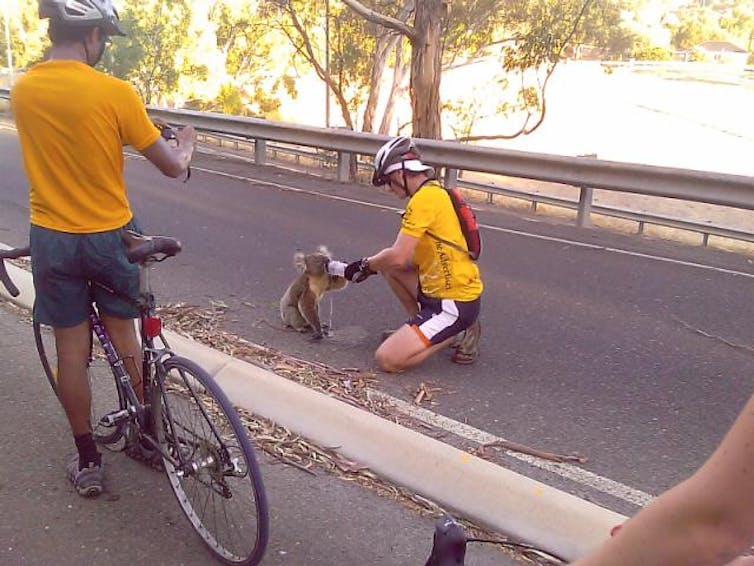
Photos of well-meaning people offering water from bottles to animals, especially thirsty koalas, often go viral online. But this is not a safe way to help koalas.
Animals must be allowed to drink water themselves, rather than us pouring water into their mouths. Animals, such as koalas, can’t drink quickly and poured water can fill their lungs, leading to potentially fatal aspiration pneumonia.

Still, providing safe, fresh drinking water is one crucial and practical way we can help them as summer grinds on.
This is particularly important since recent storms have washed ash, sediment and chemicals from burnt infrastructure into waterways, contaminating many catchments.
Water should be stationed at ground level, in a shaded location safe from predators, and in trees for birds and tree-dwelling species like possums, gliders and koalas. Check out DIY guides for building drinking fountains, or “watering pods”, for wildlife.
Sticks and rocks should be placed in the water to allow small species, such as reptiles, to climb out if they fall in. Water must be checked and changed regularly to ensure hygiene and avoid the spread of disease. And pets must be kept away from these locations (especially cats).
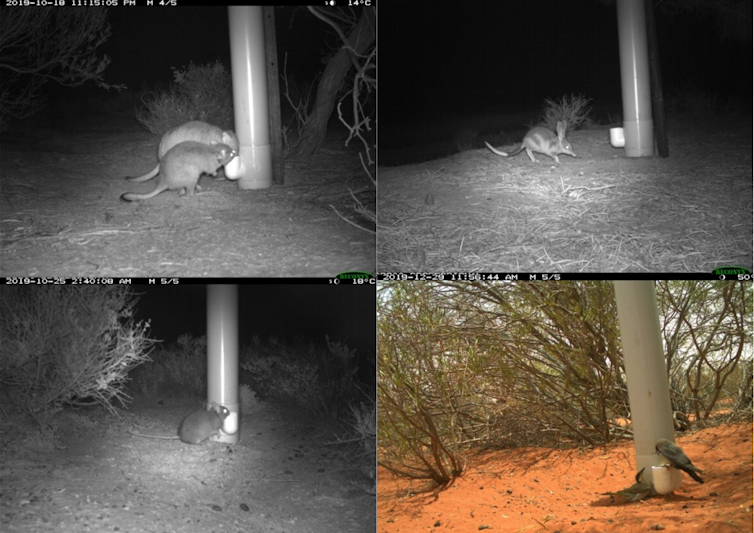
Authorities are searching the fire grounds for injured animals, and the public is reminded to avoid these areas until they’re confirmed as safe to enter.
But if you happen upon an injured survivor, what should you do?
First of all, call government agencies or trained wildlife rescuers, who can assist any injured wildlife.
Many animals may be in pain and frightened and some, including kangaroos, koalas and wombats, are potentially dangerous if approached. In urgent cases, such as when an animal is in obvious distress or has clear injuries, some animals can be carefully caught and wrapped in a towel, then placed in a well-ventilated, dark and secure box for quiet transport to wildlife veterinary hospitals for care.
Sadly, many animals are hit by cars during fires when they’re disoriented and panicked, and so it’s important to slow down in such areas.
You can also check animals found by roads for injuries and surviving young in pouches, and call authorities to assist. But always be careful of traffic when attending to animals on roadsides, and help other drivers be aware of you by putting hazard lights on and wearing bright clothes.
With so much vegetation burned away, supplementary feeding has gained attention following fires in New South Wales, Victoria and South Australia.
But feeding wildlife without expert advice and legal approval can do more harm than good.
Feeding inappropriate foods like processed foods, over-feeding, providing unhygienic foods or food stations, and attracting predators to food stations, can all be fatal for native wildlife.
Read more:
Fire almost wiped out rare species in the Australian Alps. Feral horses are finishing the job
Even some foods suggested online, such as bait balls (peanut butter mixes), can cause gastrointestinal issues for wildlife, potentially killing them. Similar issues can arise if wildlife are given some types of hay, vegetables, seeds, and fruits.
Supplementary feeding isn’t advised unless habitat and sources of food have been completely destroyed, and is only appropriate as a short-term emergency intervention until natural resources recover.
But leave it up to the experts and government agencies, which provide nutritionally suitable, specially developed and monitored food in extreme cases.
In some cases, fire may mean native animals are more prone to predators killing and eating them. And, depending on the habitat, it may take months or even years for plants and animals’ homes to recover sufficiently to provide safety once again.
However, new approaches – such as building artificial shelters out of fencing wire and shade cloth – may help to buy species time, keeping small mammals, reptiles and other potential prey safe from hungry mouths. This could occur both on private and public land.
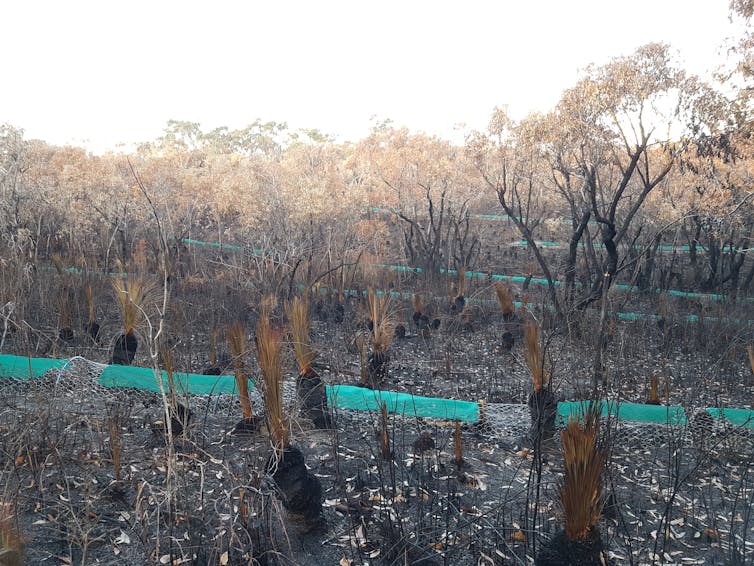
Caring for wildlife after fires, whether they’re injured or have lost their homes, is a marathon, not a sprint. And given the scale of these fires, our wild neighbours need our increased support.
Often, the most helpful thing people can do is raise and donate funds to organisations, including Zoos Victoria and the Ecological Society of Australia.
Read more:
To save these threatened seahorses, we built them 5-star underwater hotels
Some wildife species, such as bristlebirds, corroboree frogs, and mountain pygmy-possums, are being pushed to the brink of extinction and may need long-term captive breeding and release programs, or investment in active management of wild populations (such as the newly constructed feral predator-free area for Kangaroo Island dunnarts).
We can all help to make a difference and protect our remarkable and unique wildlife that so desperately needs our help.![]()
Marissa Parrott, Reproductive Biologist, Wildlife Conservation & Science, Zoos Victoria, and Honorary Research Associate, BioSciences, University of Melbourne; Dale Nimmo, Associate professor/ARC DECRA fellow, Charles Sturt University, and Euan Ritchie, Associate Professor in Wildlife Ecology and Conservation, Centre for Integrative Ecology, School of Life & Environmental Sciences, Deakin University
This article is republished from The Conversation under a Creative Commons license. Read the original article.
You must be logged in to post a comment.